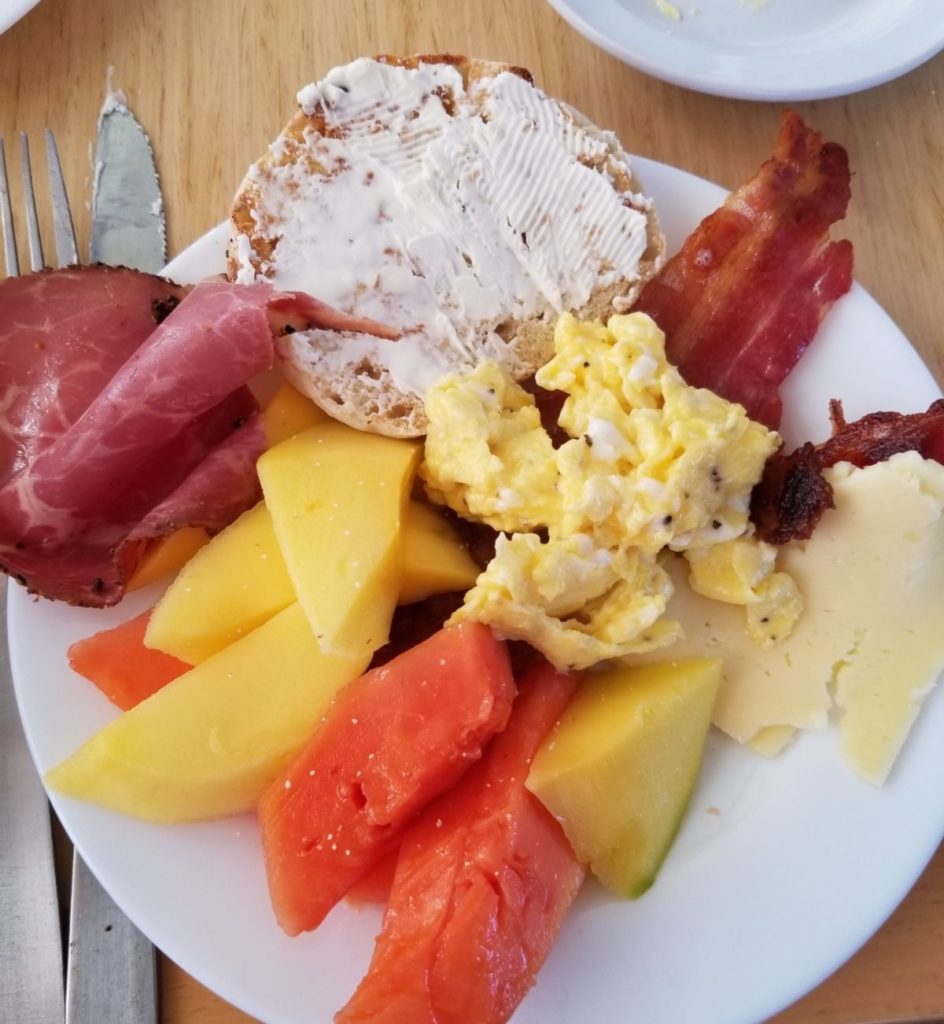Ever since Christopher Columbus dropped anchor here during his second voyage in 1493, the British Virgin Islands have been a mecca for sailors, from buccaneers and privateers to modern day pleasure seekers. Hurricane Irma dealt a crushing blow to the islands in August 2017, flattening homes, tossing expensive boats onto the rocks and obliterating most of the tourism infrastructure. Two weeks later, hurricane Maria showed up to finish the job. But a resilient local population and a loyal international community of visitors lent strength to government efforts to rebuild and within a year, BVI was back, better than ever.
I flew into Tortola, the main entry point for BVI, on a tiny twin prop, seated so close to the cockpit that I could have tapped the crisply uniformed pilot on the shoulder. Columbus was so taken with the beauty of the archipelago that he name it after St Ursula’s 11,000 virgins. My first glimpse of the islands, twinkling below as we descended from a sky darkening into night, was similarly awe inspiring.
Soon after clearing customs I was shaking hands with Markee Saracin, the youthful skipper of Barlow, a 52-foot luxury catamaran that would be my home, along with three other journalists, for the rest of the week. The best way to see BVI is by boat and if you don’t have your own, chartering is a popular, and surprisingly affordable, alternative. I had my own cabin with a queen-sized bed and en suite bathroom – no bunking-in required.

Morning brought blue skies, breakfast on deck (tropical fruit, scrambled eggs, ham, cheese, toast, bagels) whipped up by chef and first mate Ina Urfalino, and a 13-knot headwind that meant no sailing for us. Instead, we headed for The Baths at Virgin Gorda — the most popular tourist spot in BVI — under motor, with dolphins cresting in our wake and puffy clouds scudding aloft.

The Baths are indeed spectacular — huge, smooth boulders form grottoes and pools linked by corridor along the sand. To preserve the integrity of the formation, only dinghies and swimmers are allowed on the beach. We anchored and dove off Barlow’s stern, swimming in to the limpid pools that were filled with little fish and spangles of sunlight. Swimming back against the current was tough going but Ina was on hand with a restorative fruit smoothie, laced with a mid-morning tot of rum!

We motored to Spanish Town, from where Derrick Gumbs took us on a bumpy ride in his taxi to the Top of the Baths restaurant, a vantage point offering a panoramic view of the other Virgin Islands rising sharply out of the sea. On the way we saw heartbreaking evidence of Irma’s destructive path – houses gutted, boats and cars wedged weirdly in trees, piles of debris poking out of low scrub and cactus, smashed washing machines and fridges scattered about, visited by flitting yellow butterflies. Gumbs and his wife were at home during the tempest, watching in terror as their roof blew away.
From the Top of the Baths (after a lunch of mahi mahi and excellent onion rings), we drove on, Gumbs’ ramshackle taxi making a vertiginous climb to Gorda Peak, highest point on the island. Looking beyond dollhouse-sized Spanish Town below, I spotted cranes in the distance — Richard Branson, rebuilding his house on Necker Island.
From Virgin Gorda we motored on Barlow to Anegada, sipping cocktails as the sun went down and blue water changed to gold. A dinghy ride took us to Neptune’s Treasure, a waterside restaurant run by four generations of the Soares family, originally from the Azores. Pam Soares is the talent in the kitchen, turning out local specialties with a deft hand and a delicate touch. Her curried shrimp was elegantly restrained – plump, tender shrimp in a clear broth sweetened with lots of melted onion and with just a hint of curry powder. On the side, warm Portuguese bread rolls.

Anegada is the only coral atoll in BVI, rising just 28 feet above sea level at its highest point. Its low elevation spared the island from much of the category five hurricanes’ damage. The landscape is covered in mangrove, scrubby vegetation and wildflowers. Horses, donkeys, cows, goats and chickens wander untethered, sharing the only road with local residents and traffic. The horseshoe reef that surrounds Anegada is the fifth largest in the world and home to a variety of sea creatures, including lobsters, whelks and conch. The island is also home to some distinctive wildlife — the endangered Anegada Rock Iguana and Roseate Flamingoes. The latter, once hunted close to extinction for their gorgeous feathers, have been reintroduced and are thriving in salt ponds at one end of the island.
Anegada Reef Hotel is where the human action is. The tiki bar at this popular watering hole serves a legendary pina colada, along with ear-splitting reggae music. Against a backdrop of sapphire sea, dazzling white sand and powder blue sky hung with fluffy clouds, we tucked into lobster rolls and sandwiches with sides of slaw and local veg.

Kelvin “Kelly Belly” Faulkner took us in his skiff to view the Amerindian conch mounds off Anegada’s shore. Heaps of conch shells discarded in the same place for over a thousand years poke out of the water. Local fishermen are still adding to pile. From Kelvin we learned that conch will avoid a dead brother, so keeping the empty shells in one place helps to corral the live conch, making them easier to harvest.
Spiny lobster is the signature dish of the BVI and the ones that grow around Anegada are enormous. Many lobster fishermen lost their traps in the hurricanes but lobster stocks have rebounded with extra vigour since the storms also blew away many of their natural predators. Lobster features on restaurant menus throughout the islands. blackened over charcoal and served with drawn butter and lemon, eaten waterside with toes in the sand at the Lobster Trap restaurant on Anegada, it was superb.

Another day (I’d given up naming them) glistening and bright. A leisurely cruise to Jost Van Dyke island, listening to the lilting rhythms of Kenny Chesney’s BVI tribute album Songs for the Saints and sipping Ina’s rum smoothies. I could get used to this…
Seen from the water, Jost van Dyke is an imposing sight; green cliffs rising abruptly out of the ocean, tapering to a jagged peak. With only a few hundred residents, JVD has a laid back charm and a reputation for nightlife and lively beach bars. Sailors and celebrities flock to Foxy’s, a legendary hangout belonging to musician — and Chesney collaborator — Philiciano “Foxy” Callwood, MBE.
Jost van Dyke was hit hard by the hurricanes – buildings ripped apart, trees torn from their roots, essential roads destroyed. Foxy’s was badly damaged but reopened quickly, a freezer that survived providing food storage for other restaurants as they scrambled to rebuild. Some vegetation returned rapidly. Pumpkin vines, rid of competing plants, came winding down from the highlands in profusion. Papaya trees sprang up all over like weeds and the mangroves, flushed clean by massive rainfalls, rebounded with new energy.

Like the native flora, many locals who suffered devastating losses of property and livelihood see the aftermath of the storms as an opportunity to start anew. Irma was a game changer for Vinny Terranova, whose Corsairs restaurant on JVD was obliterated in the howling onslaught. The rebuild was in progress and the kitchen barely finished when we visited.
Terranova, who hails from South Dakota, thought of giving up after seeing his restaurant destroyed but couldn’t shake his commitment to the people of the islands who had worked with him. He decided to rebuild, working 24/7 for months alongside his team. “Corsairs was just a funky beachside bar,” he says, the weariness of his efforts etched on his face, “but we were known as one of the best restaurants in BVI.” And good it was — conch fritters and buffalo wings were standouts; whole snapper, skin slashed and deep fried, was good to the last bone. Wood-fired pizzas, from the spanking new brick oven, charred and chewy.

The Soggy Dollar Bar on JVD is a must-visit for rum-loving pilgrims in search of BVI’s signature drink, the Painkiller. An easy-drinking mix of fruit juice and rum, the tropical libation goes down fast and creeps up slow. Judging by the number of people stumbling around happily or dancing in the sand at the Soggy Dollar Bar, plastic cups in hand, the Painkiller was doing its job.
From JVD we sailed at sunrise for Tortola and the capital of BVI, Road Town.
Omar Hurst’s café was the hottest brunch spot in Road Town until Irma blew his doors blew out and carried off his expensive coffee roasting equipment and espresso machines. But when Hurst reopened five weeks later, he had a new waterfront location — the hurricanes had knocked down the buildings that obscured his cafe’s view. Even without espresso, Omar’s serves up a killer breakfast, with fabulously flaky croissants and eggs to order. Hurst plans to launch BVI’s first own-brand coffee when his new equipment arrives, and will open a second restaurant in a building he snapped up in a hurricane sale.

Twenty-five–year-old Matthew Callwood is the fifth generation of his family to make rum on Tortola. British sugar plantations in the 17th century exported large quantities of molasses and rum to England. When slavery was abolished in 1834, the plantation way of life came to an end but Callwood Distillery continued to operate and today proudly produces hand-crafted rums using centuries-old methods. Irma knocked out one of Callwood’s antique copper pot stills (and blew the roof off the 400-year-old building) but the other is lovingly brought into action once a year to turn pure cane juice into powerful elixirs. Quantities are too small for export but if you visit you can taste all four of Callwood’s rums and touch the distillery’s ancient stone walls for nothing more than a dollar.
Scrub Island Resort, a sprawling property with its own marina, is where I said goodbye to Barlow, Markee and Ina. Post-hurricane restoration work was still underway – the resort had re-opened just a month before. The repairs were an opportunity to renovate and upgrade the hotel but for General Manager Scott McArdle the most rewarding legacy of Irma’s unwanted visit was the bond that formed among his staff, who were able to keep their jobs, albeit re-purposed as laborers and clean-up crews. When they returned to their roles as chefs, housekeepers and groundsmen, it was with a feeling of ownership in the resort and a new pride in their work.
Irma and Maria dealt a two-fisted smackdown to BVI, not every hurricane story ended badly. Omar Hurst has a million-dollar view, Vinny Terranova’s new digs match the standard of his kitchen and Dream Yacht Charter has a new state-of-the-art berth at Scrub Island Resort. Everywhere there’s a sense of relief and recovery and an optimistic confidence in BVI’s future. The international yachting fraternity has wasted no time in coming back to this unique and beautiful island chain and the lobsters and pumpkins continue to grow fat.
Susie Ellison’s primary motivation is to eat the world. She travels light but always has salt and pepper, hot sauce and a bottle opener in her suitcase.

Susie visited the British Virgin Islands at the invitation of BVI Tourism. To learn more about a sailing vacation in BVI and other parts of the world, visit Dream Yacht Charter.


